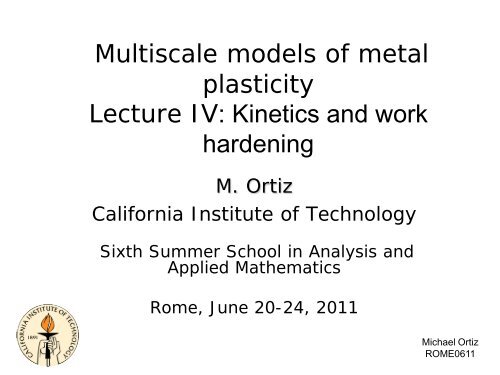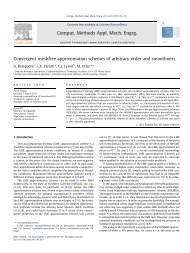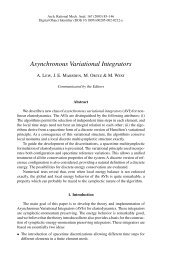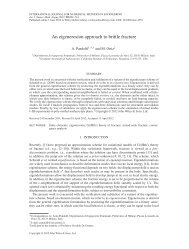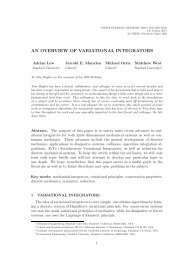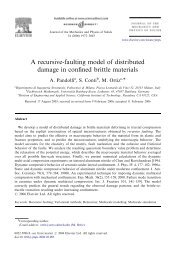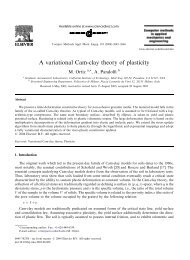Dislocation Dynamics and Plasticity - California Institute of Technology
Dislocation Dynamics and Plasticity - California Institute of Technology
Dislocation Dynamics and Plasticity - California Institute of Technology
You also want an ePaper? Increase the reach of your titles
YUMPU automatically turns print PDFs into web optimized ePapers that Google loves.
Multiscale models <strong>of</strong> metal<br />
plasticity<br />
Lecture IV: Kinetics <strong>and</strong> work<br />
hardening<br />
M. Ortiz<br />
<strong>California</strong> <strong>Institute</strong> <strong>of</strong> <strong>Technology</strong><br />
Sixth Summer School in Analysis <strong>and</strong><br />
Applied Mathematics<br />
Rome, June 20-24, 2011<br />
Michael Ortiz<br />
ROME0611
Outline <strong>of</strong> Lecture #4<br />
• Beyond energy: Kinetics<br />
• Experimental observations, dislocation mobility<br />
• The forest hardening model<br />
• Energy-dissipation functionals<br />
• Phase-field models<br />
(Humphreys <strong>and</strong> Hirsch, 1970)<br />
Michael Ortiz<br />
ROME0611
Crystal plasticity – Macroscopic behavior<br />
Uniaxial<br />
tension test<br />
Copper<br />
P. Franciosi <strong>and</strong> A. Zaoui,<br />
Acta Metall., 30 (1982) 2141-2151<br />
Taylor scaling<br />
(SJ Basinski <strong>and</strong> ZS Basinski,<br />
<strong>Dislocation</strong>s in Solids,<br />
FRN Nabarro (ed.)<br />
North-Holl<strong>and</strong>, 1979.)<br />
Michael Ortiz<br />
ROME0611
Hardening <strong>and</strong> obstacle density<br />
T. Suzuki, S. Takeuchi <strong>and</strong> H. Yoshinaga,<br />
<strong>Dislocation</strong> <strong>Dynamics</strong> <strong>and</strong> <strong>Plasticity</strong>, Springer-Verlag, 1985.<br />
Michael Ortiz<br />
ROME0611
Etch pits on a LiF crystal<br />
<strong>Dislocation</strong> velocity<br />
T. Suzuki, S. Takeuchi <strong>and</strong> H. Yoshinaga,<br />
<strong>Dislocation</strong> <strong>Dynamics</strong> <strong>and</strong> <strong>Plasticity</strong>, Springer-Verlag, 1985.<br />
Michael Ortiz<br />
ROME0611
<strong>Dislocation</strong> velocity<br />
T. Suzuki, S. Takeuchi <strong>and</strong> H. Yoshinaga,<br />
<strong>Dislocation</strong> <strong>Dynamics</strong> <strong>and</strong> <strong>Plasticity</strong>, Springer-Verlag, 1985.<br />
Michael Ortiz<br />
ROME0611
Thermal s<strong>of</strong>tening<br />
T. Suzuki, S. Takeuchi <strong>and</strong> H. Yoshinaga,<br />
<strong>Dislocation</strong> <strong>Dynamics</strong> <strong>and</strong> <strong>Plasticity</strong>, Springer-Verlag, 1985.<br />
Michael Ortiz<br />
ROME0611
Outline <strong>of</strong> Lecture #4<br />
• <strong>Dislocation</strong> motion is governed by kinetics<br />
• <strong>Dislocation</strong>s react with each other irreversibly<br />
• Energy-minimization is not enough to describe<br />
dislocation dynamics, hardening<br />
• Need kinetics, time-dependent problems!<br />
(Humphreys <strong>and</strong> Hirsch, 1970)<br />
Michael Ortiz<br />
ROME0611
The forest-hardening problem<br />
Glissile dislocation moving<br />
through forest dislocations<br />
Micro-to-macro transition,<br />
single slip<br />
Michael Ortiz<br />
ROME0611
Classical rate variational problems<br />
Michael Ortiz<br />
ROME0611
Classical rate variational problems<br />
Michael Ortiz<br />
ROME0611
Forest hardening – External energy<br />
Michael Ortiz<br />
ROME0611
Forest hardening – Stored energy<br />
moving<br />
dislocation dislocation<br />
line<br />
Michael Ortiz<br />
ROME0611
Forest hardening – Lattice friction<br />
moving<br />
dislocation<br />
dislocation speed<br />
Peierls stress<br />
(lattice friction)<br />
Michael Ortiz<br />
ROME0611
Forest hardening − Dissipation at<br />
Dissipation<br />
at junctions<br />
obstacles<br />
pinning<br />
points<br />
unfavorable junction<br />
reaction coordinate<br />
Stainier, L., Cuitino, A., Ortiz, M.,<br />
JMPS, 50 (2002) 1511-1554.<br />
favorable<br />
junction<br />
jog formation<br />
energy<br />
Michael Ortiz<br />
ROME0611
Forest hardening – Point obstacles<br />
moving<br />
dislocation<br />
dislocation speed<br />
point obstacles<br />
obstacle<br />
strength<br />
Michael Ortiz<br />
ROME0611
Forest hardening – Summary<br />
r<strong>and</strong>om obstacles<br />
periodic<br />
M. Koslowski, A.M.Cuitino <strong>and</strong> M. Ortiz,<br />
JMPS, 50 (2002) 2597-2635<br />
(dislocation lines)<br />
Michael Ortiz<br />
ROME0611
Energy-dissipation functionals<br />
“Arrow <strong>of</strong> time”<br />
Energy<br />
Dissipation<br />
Michael Ortiz<br />
ROME0611
Rate-independent problems<br />
Michael Ortiz<br />
ROME0611
Forest Hardening – Deformation theory<br />
overstress!<br />
Michael Ortiz<br />
ROME0611
Forest hardening – Pinning/depinning<br />
obstacle<br />
dislocation segment<br />
bowing between obstacles<br />
Michael Ortiz<br />
ROME0611
Forest hardening – Pinning/depinning<br />
obstacle<br />
Michael Ortiz<br />
ROME0611
Forest hardening – Pinning/depinning<br />
loops<br />
tangent<br />
obstacle<br />
Michael Ortiz<br />
ROME0611
Forest hardening − Single dislocation<br />
. . . .<br />
.<br />
.<br />
. .<br />
.<br />
. . . .<br />
. .<br />
. . . . . .<br />
.<br />
. .<br />
. .<br />
.<br />
. . . .<br />
.<br />
. . . .<br />
. .<br />
. . . . .<br />
. . .<br />
.<br />
. .<br />
.<br />
. . .<br />
obstacle point set<br />
Michael Ortiz<br />
ROME0611
Forest hardening − Single dislocation<br />
A.J.E. Foreman <strong>and</strong> M.J. Makin, Phil. Mag., 14 (1966) 911.<br />
Percolation!<br />
Michael Ortiz<br />
ROME0611
Forest hardening − Single dislocation<br />
<strong>Dislocation</strong> motion through r<strong>and</strong>om array <strong>of</strong> obstacles<br />
(Foreman, A.J.E., Makin, M.J., Phil. Mag., 14 (1966) 911)<br />
Michael Ortiz<br />
ROME0611
Forest hardening − Summary & outlook<br />
• Model is based on line tension approximation<br />
• Motion by pinning/depinning at obstacles<br />
• Model gives parabolic hardening curve, correct<br />
Taylor scaling with obstacle density<br />
• Open mathematical questions:<br />
– Limit <strong>of</strong> infinite number <strong>of</strong> obstacles (N) at fixed<br />
obstacle density, e.g., Poisson distribution <strong>of</strong> obstacles<br />
– Loading/unloading, hysteresis…<br />
Michael Ortiz<br />
ROME0611
2½D phase-field model – Assumptions<br />
slip<br />
plane<br />
0 1 2<br />
M. Koslowski, A.M.Cuitino <strong>and</strong> M. Ortiz,<br />
JMPS, 50 (2002) 2597-2635<br />
Michael Ortiz<br />
ROME0611
2½D phase-field model – Energy<br />
Core energy Elastic energy External<br />
G. Alberti, G. Bouchitté, <strong>and</strong> P. Seppecher,<br />
C. R. Acad. Sci. Paris Sér I. Math., 319 (1994) 333–338<br />
A. Garroni <strong>and</strong> S. Müller, SIAM J. Math. Anal.,<br />
36 (2005) 1943–1964; ARMA 181 (2006) 535–578<br />
Michael Ortiz<br />
ROME0611
obstacles<br />
2½D phase-field model – Time<br />
discretization<br />
M. Koslowski, A.M.Cuitino <strong>and</strong> M. Ortiz,<br />
JMPS, 50 (2002) 2597-2635<br />
dislocations<br />
Michael Ortiz<br />
ROME0611
Phase-field dislocation dynamics<br />
Stress-strain curve<br />
<strong>Dislocation</strong> density<br />
a b c<br />
d e f<br />
g h i<br />
Michael Ortiz<br />
ROME0611
Return-point <strong>and</strong> fading memory<br />
a<br />
c<br />
b<br />
e f<br />
Three dimensional view <strong>of</strong> the evolution<br />
<strong>of</strong> the slip-field, showing the the<br />
switching <strong>of</strong> the cusps.<br />
d<br />
Stress-strain curve.<br />
Michael Ortiz<br />
ROME0611 33
1 τ/τ0 0.5<br />
0<br />
-0.5<br />
-1<br />
Line-tension anisotropy<br />
-50 0 50<br />
ν = 0.0<br />
ν = 0.3<br />
ν = 0.5<br />
γ/γ o<br />
0.45<br />
ρ/ρ0 0.4<br />
= 0.<br />
b<br />
0.35<br />
0.3<br />
0.25<br />
0.2<br />
0.15<br />
0.1<br />
0.05<br />
0<br />
-50 0 50<br />
Stress-strain curve. <strong>Dislocation</strong> density<br />
ν = 0.0<br />
ν = 0.3<br />
ν = 0.5<br />
Stress-strain curve <strong>Dislocation</strong> density vs.strain<br />
ν = 0.<br />
0<br />
ν 3<br />
ν = 0.<br />
5<br />
γ/γ o<br />
Michael Ortiz<br />
ROME0611 34
Summary <strong>and</strong> outlook<br />
• The forest-hardening model predicts the<br />
observed kinetics <strong>of</strong> hardening in crystals<br />
• A full analytical treatment <strong>of</strong> the foresthardening<br />
model is still lacking<br />
• Need tools <strong>of</strong> analysis (similar to CoV) for time<br />
dependent evolution problems<br />
(Humphreys <strong>and</strong> Hirsch, 1970)<br />
Michael Ortiz<br />
ROME0611
time<br />
ms<br />
µs<br />
Metal plasticity − Multiscale analysis<br />
ns<br />
Objective: Derive ansatz-free,<br />
physics-based, predictive models<br />
<strong>of</strong> macroscopic behavior<br />
Lattice<br />
defects, EoS<br />
<strong>Dislocation</strong><br />
dynamics<br />
nm µm<br />
Subgrain<br />
structures<br />
length<br />
Engineering<br />
applications<br />
Polycrystals<br />
Lecture #4: Subgrain<br />
dislocation structures<br />
Lecture #3: <strong>Dislocation</strong> kinetics,<br />
the forest-hardening model<br />
Lecture #2: <strong>Dislocation</strong> energies,<br />
the line-tension approximation<br />
mm<br />
Michael Ortiz<br />
ROME0611


